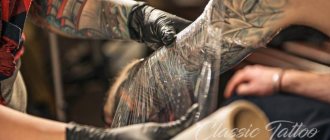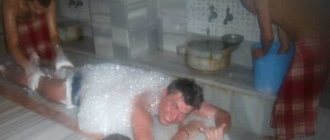Tattooing is the introduction of colored pigment under the skin using a thin needle. Depth – approximately 0.5-1 mm, area of influence – hairy part of the eyebrows. If the shape of the eyebrows needs to be changed, then the dye is applied beyond the boundaries of hair growth. This is also often done if the eyebrows are naturally very thin and you want to make them wider.
In the first days after the tattoo procedure (permanent makeup), eyebrows need care. Damaged skin should not be exposed to aggressive influences. In addition, until healing is complete, eyebrows do not look very beautiful. Therefore, plan a few days of “home” regimen after the procedure. If going outside is unavoidable, buy large sunglasses that cover your eyebrows.
Healing process
Immediately after the introduction of the pigment, the skin becomes inflamed, red, and swollen, but the next day it subsides. This is a natural reaction of the dermis to multiple needle punctures. The treatment area may “bleed” slightly, and ichor is released from it. The entire healing process, if the rules and recommendations are followed, takes up to 10 days. However, this period is purely individual. The main thing is to follow the instructions of the specialist who performed the procedure.
How to properly care for your eyebrows immediately after the tattoo procedure?
After applying permanent makeup, the artist will apply a thick layer of Vaseline or other protective ointment to the eyebrows. The skin should rest for the first two hours, so you don’t need to do anything else.
After two hours, rinse the tattoo area with cool water. Use antibacterial soap to wash off the protective ointment. Do not scrub under any circumstances, this will only further injure the irritated area. After five minutes, apply a thin layer of Bepanten or Depanthenol ointment to dry skin.
Important! If you apply the ointment generously, you can create a “greenhouse effect”, which will negatively affect the condition of the eyebrows and cause discomfort.
In the first 3-4 days, the skin should be treated every 2-3 hours. Procedure:
- With a soft, lint-free, dry cloth, remove any remaining ointment without rubbing the skin or pressing;
- gently (without pressure) apply Chlorhexidine or other antiseptic as recommended by the specialist;
- wait 10-15 minutes;
- Apply a thin layer of “Bepanten” or “Depanthenol”.
Important! Do not apply hydrogen peroxide or products containing alcohol to your skin.
In the early recovery period, you should not pluck hairs in the area of permanent makeup applied or scratch your eyebrows. It is necessary to exclude unnecessary exposure to water, especially from reservoirs, as it can cause infection. Do not swim in the pool - additives for water disinfection can damage the tattoo. You will also have to refrain from visiting the bathhouse or sauna.
Swelling is normal. However, it should pass in 1-2 days. If this does not happen, take an antihistamine. For example, Zodak does not give any drowsiness effect. Pain may also occur and can be relieved with simple painkillers.
Important! If the pain is very severe, contact the artist who performed the tattoo or a dermatologist.
General contraindications after tattooing
During the healing period of the tattoo area, any contact with hot steam and water is completely prohibited. Prohibitions:
- Do not use hot water when bathing;
- prolonged exposure to the sun is undesirable;
- You should not exert physical influence on the tattoo (rub, scrape, scratch).
It is important to remember that all paints used for painting are affected by the same factors. This:
- hot water, sweat;
- steam and elevated temperature;
- Sun rays;
- salt;
- abrasive materials, broom.
When hovering, the broom scrapes the stratum corneum of the skin from the damaged area. Some paint sticks to the skin. As a result, the drawing loses its richness. The boundaries look blurry.
Going without a bath for a month after getting a tattoo is unthinkable. Hygiene procedures are acceptable already on the day of tattooing. But you should be extremely careful. After three to four hours, you can remove the sterile bandage that the tattoo artist applied. Afterwards you can take a shower. The water should not be hot. Do not use brushes or sponges. Be sure to use an antibacterial detergent. After a shower, the tattoo should be blotted with a sterile napkin.
How to care for eyebrows after permanent makeup after 3-4 days?
From the fifth day, it is enough to smear the skin with healing ointments 3-4 times a day. Full course – 7-10 days. Approximately 3-4 days after tattooing, the skin will peel off, which confirms that the healing process is proceeding correctly.
In the morning there is a feeling of very dry skin. In this case, you can apply a thin layer of Vaseline for half an hour. After this - standard processing.
In the first week, you should not apply cosmetics to the eyebrow area, because this will inevitably injure the skin, clog pores and require careful rinsing.
Is it possible to steam a tattoo with a broom?
After getting a tattoo, a crust appears at the site of the design, which cannot be removed on your own. This crust is a dead layer of skin that protects the new layer that is forming.
Using a steamed broom will only harm the tattoo. Thin branches of a broom will be real rods for a healing tattoo. Why subject a sore spot to additional aggressive procedures?!
Any interference with the wound healing process will cause an inflammatory process, which can lead to loss of pattern pigment.
But if the pattern is small and it is located far from the broom massage area, then soaring is possible...
What can't you do?
- For about 10 days you cannot steam the treatment area, go to the bathhouse or sauna, or use scrubs.
- Do not over-hydrate your skin if it is inflamed.
- It is advisable to protect the skin from sea water and chapping.
- For 2-3 weeks, avoid tanning - natural and in a solarium. For the next 3-6 months, you should apply sunscreen to your eyebrows before going out in the sun.
Nourishing creams should not be used. They often have an alcohol base and do not promote healing, but rather slow down the process.
Bath and tattoo in Japan
Until 500, tattoos adorned the bodies of only emperors. Later, the art of body painting was a symbol of the underworld - the yakuza.
Tattoos were made on the most prominent parts of the body and told about belonging to any group in criminal circles. Extensive tattoos became a hallmark of the Yakuza.
It is noteworthy that Yakuza members are prohibited from showing tattoos on their bodies, with the only exception being participation in festivals.
I dwelled in such detail on Japan because after the tattooing procedure, members of the yakuza visit the bathhouse...
Yes, exactly our own, Japanese bathhouse. And this bathhouse is not even a relative or close relative of our bathhouse.
The entire bath culture in Japan is far from our bathhouse and Finnish sauna; the effect on the body is completely different.
A bathhouse in Japan is a huge barrel of hot water. The room itself where the barrels are located does not heat up in any way, the moisture is moderate. After plunging into hot water, a person immediately returns to normal temperature.
Let’s not forget about the unprecedented abilities of trained members of the Yakuza; we, ordinary Russian people, are very far from their level.
What happens if you don't undergo rehabilitation?
If you ignore the rehabilitation period, the tissues will not heal properly, which will reduce the effectiveness of the hernia surgery. Muscles and ligaments will remain undeveloped, which will have a bad effect on flexibility and the ability to withstand stress. The result is a recurrence of the vertebral hernia, the return of discomfort.
Each type of intervertebral hernia has serious complications, so you should not delay treatment.
See how easy it is to get rid of a hernia in 10 sessions
general information
Surgery involving skin grafting is called dermatoplasty. The operation is prescribed for the treatment of burns and large-area wounds for victims of any age, as well as in a number of other cases:
- burns;
- wounds, including after surgery;
- diabetic foot, accompanied by ulcerative defects that do not respond well to conservative treatment methods;
- operations related to limb defects, as well as elephantiasis.
Skin grafting is contraindicated at elevated temperatures, wound infection and in the presence of decompensation of somatic diseases. Material for skin grafting can be taken from 3 sources:
- skin of the patient or donor;
- animal skin, after special preparation;
- artificial materials from biological polymers and cell coatings.
The material is selected based on clinical indications and its availability. According to the classification of dermatoplasty operations, the following types of surgical intervention are distinguished:
- autodermoplasty;
- allodermoplasty;
- application of cellular products.
Involves using the patient's own skin. It is carried out if skin defects occupy no more than 35–50% of the entire body. A thin layer of skin is cut off from a healthy part of the back or leg and transplanted onto the injured area.
In this method, the rehabilitation process is especially complex. According to studies, after autodermoplasty repairs, up to 10% of first-degree burns, 55 to 62% of second-degree burns, and 30 to 40% of third-degree burns develop keloid and hypertrophic scars.
They are the most problematic and sensitive of possible scars, because in the process of development they cause inconvenience to a person: they aesthetically spoil the appearance, cause itching, redness, and increased temperature at the site of injury. And a hypertrophic scar also grows in size over time, capturing healthy areas of the skin.
It is prescribed if damaged skin makes up more than 50% of the entire body or if there are contraindications to autodermoplasty. In this case, donor, animal or synthetic skin is used.
It is carried out in a few medical centers with large scientific departments. For the operation, biological material taken from the patient himself is used.
Based on the timing and rehabilitation, dermatoplasty is divided into primary and secondary. The primary one is carried out during the patient’s hospitalization, without waiting for regenerative processes in the dermis. A secondary transplant is carried out a week later, when granulation tissue from immature connective tissue begins to form.
In addition, in surgery there are concepts of free and non-free skin grafting . In the first case, the flap of skin is completely transferred to the surface of the wound, and in the second, the skin area has a nourishing pedicle, which provides a better healing effect.
In case of severe burns and a large area of damage, it is necessary to contact a combustiologist. This physician treats complex injuries and works closely with radiologist, anesthesiologist, transplant surgeon and other specialists.
Combustiologists use the following working methods:
- Treatment under a bandage . The burn is treated with an antiseptic and prescribed medications, and a bandage is applied. Bandages must be sterile, and be sure to change them every specified period of time.
- Therapy in a bacteria-free environment . A victim with open burns is placed in a special sterile box. This method is used in cases where it is impossible to apply a bandage either due to large areas of the wound or its difficult accessibility (perineum, face).
- Necroectomy and eschar management . Abscesses and dead cells are removed through surgery.
- Skin grafting . It is considered to be the final stage of therapy. It is carried out on large affected areas when natural cell regeneration is impossible.
The surgical expert knows dozens of skin grafting operations. However, in all cases, the operated part of the body must be carefully cared for to avoid the occurrence of a wound after skin grafting.
Find out which method of correcting scars and stretch marks is optimal for you!
doctor Svetlana Viktorovna Ogorodnikova.
doctor
What determines the cost of removal?
More sessions = more cost. The number of sessions depends on:
· On the scale of the tattoo. The larger it is, the longer it will take to remove it.
· From the color of the tattoo. The darker the pigment, the more it absorbs laser radiation and is removed faster. Red color takes longer to appear. The most problematic shades are orange, green and yellow. White and flesh colors are not output.
· On the quality of ink. Professional pigment is easier and faster to remove than mascara and unknown mixtures.
· On the number of colors in the tattoo. The more complex the tattoo palette, the more wavelength settings and other parameters of the device will be required, that is, the more subtle and longer the cosmetologist’s work.
· From the technique of tattooing.
· From the depth of the pigment. The deeper, the more difficult it is to remove the tattoo.
· From the freshness of application. The older the tattoo, the easier it is to remove.
· From the characteristics of the body. The cosmetologist only destroys the tattoo paint with a laser, and your body removes it. It is easier for a healthy body with a good immune system to cope with this.
When to see a doctor during rehabilitation
Contact your doctor immediately if the following symptoms appear:
- back pain that does not subside and intensifies;
- burning in the area of the damaged disc;
- urinary disturbance;
- pain in the abdomen, arms, legs;
- numbness of hands, feet;
- heat;
- spasm, tension in the back muscles;
- too much swelling in the area of the diseased disc;
- ichor that oozes from the stitches.
These symptoms indicate complications that may result from infection in the wound, purulent inflammation, the onset of pathological narrowing (stenosis) of the spinal canal, when bone/cartilaginous structures affect the nerve roots, and other complications, including recurrence of intervertebral hernia.
A little history
Tattoos appeared in Russia much later than in Europe.
At the beginning of the twentieth century, Russian sailors became acquainted with the art of tattooing, adopting the fashion from foreign sailors. Tattoos entered the everyday life of Russian people en masse with the advent of crime. Tattoos have become part of recognition in prisons and places of detention.
During the Soviet era, tattoos were common in the army, navy, and criminal structures. Often expressed a person’s attitude to politics, the meaning of life, and to people of the opposite sex.
Some religious denominations prohibit tattoos. Islam, Judaism and even Christianity are against drawings and patterns on the body; Muslims consider tattoos to be a sin.











